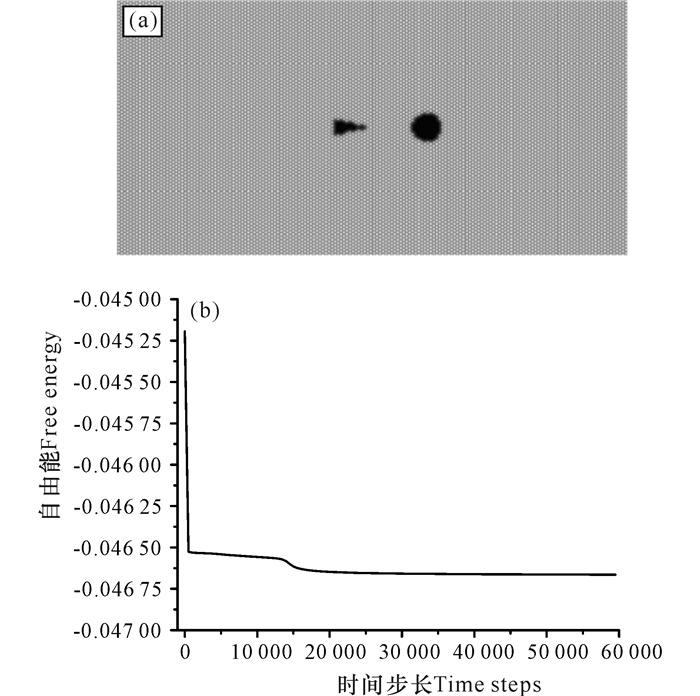2. 玉林师范学院物理科学与工程技术系,广西玉林 537000
2. Institute of Physics Science and Engineering Technology, Yulin Normal University, Yulin, Guangxi, 537000, China
【研究意义】材料的变形与破坏大都源自材料的微结构,如空位、位错、晶界与微裂纹等。要深入研究材料的变形与破坏的特性与机理,还需要深入到微纳观层次[1-3]。因此,研究纳米级裂纹的萌生和扩展对预防材料的断裂,提高构件的使用寿命具有重要意义[4-6]。实验研究表明,金属材料的疲劳断裂过程由纳微裂纹的扩展过程决定[7]。在当前的实验测量条件下,对材料的纳米级裂纹扩展很难实时观测[8],因此,发挥计算模拟实验的优势,应用其研究微纳米尺度的裂纹扩展就显得极为迫切和重要[8]。【前人研究进展】近几年有许多关于晶体相场(PFC)方法的应用模拟研究[3-12],例如模拟位错滑移、攀移和湮没、相结构转变、异质外延生长、纳米晶粒长大等。目前,材料微裂纹扩展的研究主要集中在以下几个方面:将加工变形的外界作用因素引入PFC模型中,建立形变和位错动力学的PFC模型,用于超塑性、疲劳、断裂、蠕变等行为和性能的机理研究。但应用先进的PFC模型,研究在一定条件下初始缺口形状对裂口分裂的影响还较少。【本研究切入点】晶体相场方法[13-14]是基于密度泛函理论提出的。通过引入周期性原子密度函数,很自然地耦合了弹性效应、位错运动等周期性结构物理特性;由于晶体相场方法能够很好地描述扩散时间尺度上的微结构演化行为[3],因此,更适合用于研究微纳米尺度上的裂纹扩展细节[9, 15]。【拟解决的关键问题】本研究应用PFC方法研究初始三角和圆心裂口在拉伸应变作用下的裂纹扩展演化,分析了裂纹起裂扩展及裂尖应力分布[16-17],揭示裂纹韧性断裂、脆性断裂的机理。
1 PFC模型与方法PFC模型能够揭示晶体点阵周期结构特性以及空间分辨尺度为原子尺度,时间尺度为扩散时间尺度下的纳微结构演化。对于固态晶体材料,其原子的位置呈规则周期性排列,通过引入周期性相场变量ρ(r),其空间分布的极大值位置对应于原子点阵的位置;对于均匀相(液相等)中的原子密度分布为均匀分布,其值为常量。用周期原子密度函数ρ(r)作为相场变量,要符合上述两方面的要求,其表达式[13-14, 18]可以写成:
| $ \rho \left( r \right) = \sum\limits_{n, m} {{a_{n, m}}{e^{iG \times r}}} + {\rho _0}, $ | (1) |
式中,等号右边第1项反映的是晶格原子的周期排列结构特征,其中G为倒格子矢量,r为空间坐标矢量;第2项反映的是均匀相(如液相)等的原子密度均匀分布。此时,系统无量纲的自由能函数可以写成[9]
| $ F = \int {\left\{ {\frac{\rho }{2}\left[{\gamma + {{\left( {1 + {\nabla ^2}} \right)}^2}} \right]\rho + \frac{{{\rho ^4}}}{4}} \right\}{\rm{d}}{r^3}, } $ | (2) |
式中,γ为与温度有关的参数;∇2为拉普拉斯算符。
在单模近似下,由二维体系自由能取极小值,可以求得公式(2)的晶体相的一个稳定特解[9]为
| $ \rho \left( r \right) = A\left[\begin{array}{l} \cos \left( {qx} \right)\cos \left( {\frac{{qy}}{{\sqrt 3 }}} \right)-\\ \frac{1}{2}\cos \left( {\frac{{2qy}}{{\sqrt 3 }}} \right) \end{array} \right] + {\rho _0}, $ | (3) |
式中,
本研究采用保守场Cahn-Hilliard动力学方程[5, 9]描述原子密度随时间的演化。该方程具体如下:
| $ \frac{{\partial \rho }}{{\partial t}} = {\nabla ^2}\frac{{\delta F}}{{\delta \rho }} = {\nabla ^2}\left\{ {{\rho ^3} + \left[{\gamma + {{\left( {1 + {\nabla ^2}} \right)}^2}} \right]\rho } \right\}, $ | (4) |
式中,t为时间变量。对无量纲动力学演化方程(4),采用半隐式傅里叶伪谱方法[18-20]求解。
2 样品制备及施加应变依据高英俊等[19]给出的均匀相和条状相的能量密度函数表达式,可得到PFC的二维相图[6],本研究选用三角相的无量纲密度变量ρ0=0.49来表征晶体相,温度参数选取γ=-1.0。初始裂口区域内液相值和温度参数分别选用ρ0=0.79,γ=-1.0。缺口直径(本研究设置圆形及三角形缺口)R=30个格子,原子排列取向角θ=5°。通过自由能密度函数能够得到一个含有初设缺口样式的初始样品。经弛豫之后,使缺口内应力释放,得到稳定的初始缺口样品原子排列图。弛豫后得到样品及其自由能曲线如图 1所示。从自由能曲线能够清晰的看出体系能量已经达到了最低的状态,系统已趋于稳定。

|
图 1 弛豫后样品原子排布(a)和弛豫过程中的自由能变化(b) Fig.1 The sample of the atomic arrangement after relaxation (a) and the change of free energy during relaxation (b) |
本研究针对样品在y轴拉应变作用下裂纹起裂及其扩展的演化,设置模拟样品尺寸1024Δx×512Δy,模拟的空间步长Δx=Δy=π/3,时间步长Δt=0.05,模拟时间设置为60万步。体系动态应变为
图 2a是弛豫60 000步后稳定样品。由裂纹扩展图 2可以看出,三角形裂口两侧裂纹起裂与扩展情况存在明显的差异。图 2b是t=350 000步时,圆形缺口两侧产生位错的滑移,萌生裂纹,三角形缺口右侧也产生一对位错,萌生裂纹。图3c显示出三角形缺口右侧裂纹慢慢扩展,左侧上端发射一对位错,下端则沿着[121]方向出现解理裂纹,而圆形缺口两侧形成的空洞并不是连通的,表明二者之间存在弹性变形区域。图 2d表明,三角形向右扩展的裂纹与圆形缺口向左扩展的裂纹即将“连通”,同时,圆形缺口与其右侧空洞也将“连通”,该弹性变形区消失;三角形缺口左侧上端萌生位错,位错滑移引起塑性变形产生空位,而其下部的解理裂纹继续沿着解理面扩展。图 2e展示三角形与圆形缺口中间的裂纹已经“连通”形成主裂纹,而三角形缺口左侧上端由于塑性变形,位错滑移,在离缺口不远处诱发出更多的空位,这一现象是典型的韧性断裂特征,而其下端的裂纹继续沿着[121]方向解理扩展,是典型的脆性断裂特征。圆形缺口右侧裂纹与缺口相连接,裂纹呈“之”字型扩展延伸。随着时间的推移,由图 2f可见,当运行到t=525 000时间步时,三角形缺口左侧上部出现更多的空位,下部裂纹扩展方向发生转向,由[121]方向变为[211]方向,然后又转回[121]方向,继续沿着[121]方向解理扩展。由图 2g~h可见,上述趋势更加明显。

|
(a)t=0;(b)t=350 000;(c)t=375 000;(d)t=400 000;(e)t=475 000;(f)t=525 000;(g)t=550 000;(h)t=600 000 图 2 样品的裂纹扩展演化貌图(左)及其对应的应力分布(右) Fig.2 The crack evolution morphology of the sample (left) and its corresponding stress distribution (right) |
从图 2彩色的应变分布图中可以清晰的看出样品在不同应变下的裂纹应变场分布情况。在应变施加初期,应变场强较弱,只在裂口附近有变化,形成二个环状的分布,在萌生裂纹的区域,颜色呈金黄色,表明该区域应变较高,出现应变集中。随着裂纹扩展,应变场环绕着裂纹周围,形成大的椭圆环状,在裂尖附近和位错区域,都存在应变集中。
4 结论三角形裂口两侧裂纹起裂与扩展情况存在明显的差异,左侧裂口出现韧、脆两种类型的裂纹生长,而右侧的缺口是解理裂纹扩展;圆形裂口两侧的裂纹萌生,开始时是发射位错,然后形成空洞,空洞与圆形缺口并不连通,这是韧性起裂的特征,随着裂纹进一步的发展,逐渐转变为解理扩展。
在应变施加初期,应变场强较弱,只在裂口附近有变化,形成二个环状的分布,在萌生裂纹的区域,出现应变集中。随着裂纹扩展,应变场环绕着裂纹周围,形成大的椭圆环状,在裂尖附近和位错区域,都存在应变集中。
| [1] |
GAO Y J, WANG J F, LUO Z R, et al. Nano-twin structure simulation with phase field crystal method[J]. Chinese Journal of Computational Physics, 2013, 30(4): 577-581. |
| [2] |
刘晓波, 徐庆军, 刘剑. 铝裂纹扩展行为的分子动力学模拟[J]. 中国有色金属学报, 2014, 24(6): 1408-1413. LIU X B, XU Q J, LIU J. Molecular dynamics simulation of crack propagation behavior of aluminum[J]. The Chinese Journal of Nonferrous Metals, 2014, 24(6): 1408-1413. |
| [3] |
黄世叶, 李胜男, 胡绪志, 等. 晶界位错运动的空位晶体相场模拟[J]. 广西科学, 2016, 23(5): 459-464. HUANG S Y, LI S N, HU X Z, et al. Vacancy phase-field-crystal simulation of dislocation motion of grain boundary[J]. Guangxi Sciences, 2016, 23(5): 459-464. |
| [4] |
黄礼琳, 叶里, 胡绪志, 等. 不同晶向取向的裂纹扩展演化模拟[J]. 广西科学, 2016, 23(5): 454-458, 469. HUANG L L, YE L, HU X Z, et al. Simulation study of crack propagation and evolution in different crystal orientations[J]. Guangxi Sciences, 2016, 23(5): 454-458, 469. |
| [5] |
温振川, 宁岁婷, 张睿, 等. 纳米级缺口起裂临界条件的晶体相场模拟[J]. 广西科学, 2016, 23(5): 448-453. WEN Z C, NING S T, ZHANG R, et al. Phase-field-crystal simulation of critical conditions for the crack initiation of nanoscale notch[J]. Guangxi Sciences, 2016, 23(5): 448-453. |
| [6] |
杨涛, 陈铮, 董卫平. 应力诱发双位错组亚晶界湮没的晶体相场模拟[J]. 金属学报, 2011, 47(10): 1301-1306. YANG T, CHEN Z, DONG W P. Characteristics of crystal phase field annihilation in sub-grain boundary of stress-induced double dislocation group[J]. Acta Metallurgica Sinica, 2011, 47(10): 1301-1306. |
| [7] |
YU Y M, BACKOFEN R, VOIGT A. Morphological instability of heteroepitaxial growth on vicinal substrates:A phase-field crystal study[J]. Journal of Cryst Growth, 2011, 318(1): 18-22. DOI:10.1016/j.jcrysgro.2010.08.047 |
| [8] |
OONO Y, PURI S. Computationally efficient modeling of ordering of quenched phases[J]. Phys Rev Lett, 1987, 58(8): 836-839. DOI:10.1103/PhysRevLett.58.836 |
| [9] |
高英俊, 罗志荣, 邓芊芊, 等. 韧性材料的微裂纹扩展与分叉的晶体相场模拟[J]. 计算物理, 2014, 31(4): 471-478. GAO Y J, LUO Z R, DENG Q Q, et al. Phase-field-crystal modeling of microcrack propagation and branching in ductile materials[J]. Chinese Journal of Computational Physics, 2014, 31(4): 471-478. |
| [10] |
孔令一, 卢昱江, 邓芊芊, 等. 二维大取向角对晶界湮没过程的晶体相场模拟[J]. 广西科学院学报, 2017, 33(4): 228-233. KONG L Y, LU Y J, DENG Q Q, et al. Phase field crystal simulation of grain boundary annihilation with two dimensional large orientation angle[J]. Journal of Guangxi Academy of Sciences, 2017, 33(4): 228-233. |
| [11] |
邓芊芊, 胡绪志, 黄礼琳, 等. 条状晶位错运动的晶体相场模拟[J]. 广西科学院学报, 2017, 33(4): 223-227. DENG Q Q, HU X Z, HUANG L L, et al. Phase field crystal study on dislocations movement in strip grain[J]. Journal of Guangxi Academy of Sciences, 2017, 33(4): 223-227. |
| [12] |
叶里, 胡绪志, 黄礼琳, 等. 拉应力作用下晶界位错运动过程的晶体相场模拟[J]. 广西科学, 2016, 23(5): 470-473, 484. YE L, HU X Z, HUANU L L, et al. Phase-field-crystal simulation of grain boundary dislocation motion under tensile stress[J]. Guangxi Sciences, 2016, 23(5): 470-473, 484. |
| [13] |
ELDER K R, KATAKOWSKI M, HAATAJA M, et al. Modeling elasticity in crystal growth[J]. Phys Rev Lett, 2002, 88(24): 245701-245705. DOI:10.1103/PhysRevLett.88.245701 |
| [14] |
ELDER K R, GRANT M. Modeling elastic and plastic deformations in nonequilibrium processing using phase field crystals[J]. Phys Rev E, 2004, 70(5): 051605-051618. DOI:10.1103/PhysRevE.70.051605 |
| [15] |
满海, 胡绪志, 宁岁婷, 等. 晶界萌生裂纹扩展的晶体相场模拟[J]. 广西科学院学报, 2017, 33(4): 246-249, 260. MAN H, HU X Z, NING S T, et al. Phase field crystal simulation of crack nucleation and extension from grain boundary[J]. Journal of Guangxi Academy of Sciences, 2017, 33(4): 246-249, 260. |
| [16] |
YU Y M, BACKOFEN R, VOIGT A. Morphological instability of heteroepitaxial growth on vicinal substrtes:A phase-field crystal study[J]. Journal of Crystal Growth, 2011, 318(1): 18-22. DOI:10.1016/j.jcrysgro.2010.08.047 |
| [17] |
STEFANOVIC P, HAATAJA M, PROVATAS N. Phase field crystal study of deformation and plasticity in nannocrystalline materials[J]. Physical Review E, 2009, 80(4): 046107-046114. DOI:10.1103/PhysRevE.80.046107 |
| [18] |
CHEN L Q, YANG W. Computer simulation of the domain dynamics of a quenched system with a large number of nonconserved order parameters:The grain-growth kinetics[J]. Phys Rev B, 1994, 50(21): 15752-15756. DOI:10.1103/PhysRevB.50.15752 |
| [19] |
高英俊, 罗志荣, 黄创高, 等. 晶体相场方法研究二维六角相向正方相结构转变[J]. 物理学报, 2013, 62(5): 050507-050510. GAO Y J, LUO Z R, HUANG C G, et al. Phase-field-crystal modeling for two-dimensional transformation from hexagonal to square structure[J]. Acta Physica Sinica, 2013, 62(5): 050507-050510. |
| [20] |
JAATINEN A, ALA-NISSILA T. Eighth-order phase-field-crystal model for two-dimensional crystallization[J]. Phys Rev E, 2010, 82(6): 061602. DOI:10.1103/PhysRevE.82.061602 |
 2017, Vol. 24
2017, Vol. 24 


